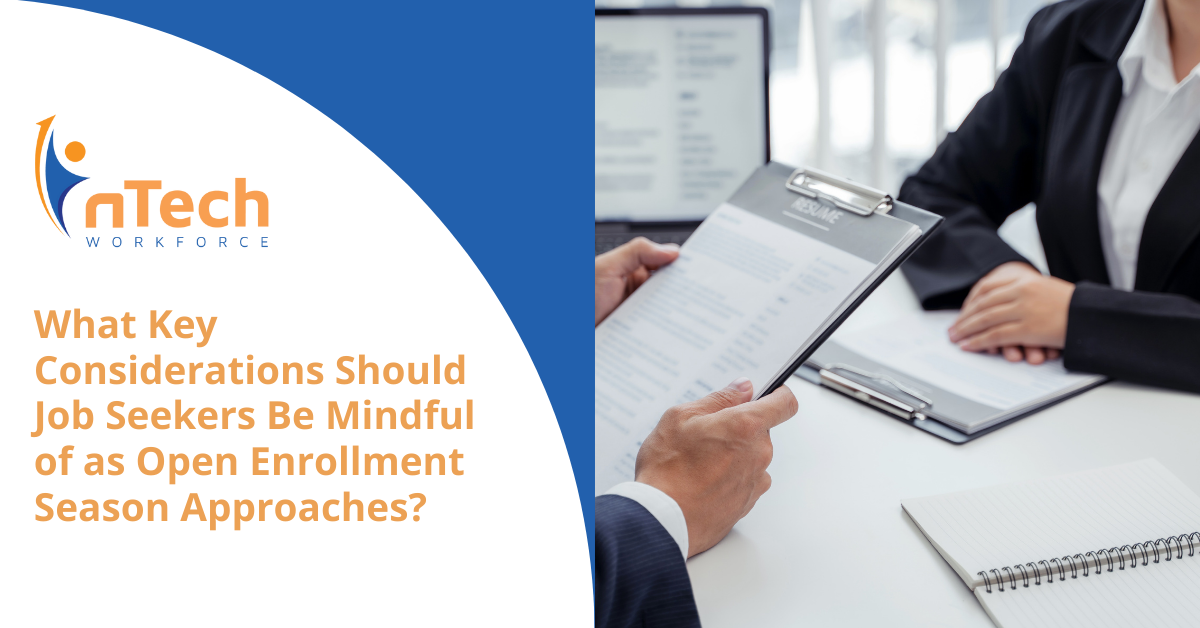As defined by an article from Forbes, open enrollment is: “The time of year when you can sign up for health insurance or make changes to your coverage.” Navigating the job market involves more than just comparing salaries; it's also about understanding and evaluating the comprehensive benefits packages offered by potential employers. As open enrollment season approaches, this becomes even more critical.
Kayla Raynor, Compensation and Compliance Lead at nTech Workforce emphasizes the importance of a thorough assessment of employee benefits. This blog delves deeper into what job seekers should consider during this crucial period.
What Should Job Seekers Consider When Evaluating Benefits Packages From Potential Employers?
According to an article from Indeed: “While all candidates have individual needs when it comes to benefits, asking the right questions can help you better understand the details of your offer and make your ultimate decision clearer.”
Evaluating employee benefits packages requires a careful look at various components. Job seekers should thoroughly assess health insurance options, including the extent of coverage and the balance between deductibles and premiums. According to Raynor: “When evaluating employee benefits packages from potential employers, job seekers should consider several factors to ensure that the overall package aligns with their personal needs and priorities.” Here are some factors she recommends considering:
- Retirement plans, such as 401(k)s are also vital to consider. Understanding the employer's contributions, matching programs, and the vesting period can significantly impact long-term financial planning.
- The assessment should extend to time off and leave policies. Evaluating vacation, sick days, paid time off, and family leave policies provides insight into the company’s regard for work-life balance.
- Flexible Spending Accounts (FSAs) and Health Savings Accounts (HSAs) offer tax-advantaged ways to manage healthcare and dependent care expenses, which can be a significant benefit.
- Ancillary benefits, like life and disability insurance, provide additional security and peace of mind which should not be overlooked.
- Finally, job seekers should consider factors like work-life balance policies, professional development opportunities, wellness programs, employee assistance programs, stock options, and commuter benefits. These elements often reflect the company's culture and values, which are as crucial as the financial aspects of a benefits package.
How Can Job Seekers Navigate Health Insurance Options?
Open enrollment presents an opportunity for job seekers to tailor their health insurance to their evolving needs. Raynor points out that understanding the nuances of different plans is essential. “Navigating health insurance options during open enrollment can be complex, but careful consideration and understanding of their needs can help job seekers make informed decisions,” Raynor shares. They should compare aspects like network breadth, premium costs, and coverage details, weighing these against their personal and family health requirements.
Job seekers should also be proactive in calculating the total cost implications of each plan. This includes considering the potential expenses of co-pays and prescription medications. According to a recent article from SHRM: “72 percent of employed Americans agree that, because of inflation, they will spend more time reviewing their benefit elections during open enrollment to help them get the most from their options.” Exploring options like HSAs or FSAs can offer financial benefits and assist in managing out-of-pocket healthcare costs.
How Can Job Seekers Become Aware of Their Benefits?
Awareness begins with research and evaluating your own needs, as noted by Indeed. Here are some tips from Raynor on how to stay ahead of the curve:
- Before applying for a job, investigating the company’s benefits on their website can offer initial insights.
- During interviews, asking specific questions about benefits can reveal much about the employer's priorities and how they support their staff.
- During open enrollment, attending orientation sessions and thoroughly reviewing all provided materials can clarify changes and options available.
- Setting reminders for important dates ensures that opportunities to adjust benefits are not missed.
- When uncertainties arise, scheduling meetings with HR can provide necessary clarifications.
What Resources Are Available?
According to Raynor, a variety of resources can assist job seekers in understanding employee benefits:
- Company websites and job descriptions often provide a benefits overview.
- Employee handbooks can offer in-depth details, while recruiters and HR representatives can answer specific questions and provide additional context.
- Reading through benefit plan summaries and visiting carrier websites can also provide a more comprehensive understanding of what is offered.
Understanding employee benefits is a crucial aspect of job hunting, especially during open enrollment season. A thorough evaluation of these benefits can lead to better job satisfaction and work-life balance. Job seekers should leverage all available resources to make informed decisions that align with their personal and professional goals.
nTech Workforce strives for healthy, happy, and successful employees and contingent workers. Click here to view nTech’s Employee Benefits. Click here to view current relevant openings.





